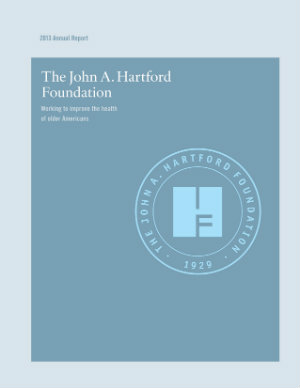This is the second in a three-part Health AGEnda series on the Hartford Foundation’s 2013 Annual Report: Spreading Innovation Through Collaboration.
 Although he was a star in a different field, something basketball legend Michael Jordan once said applies equally to the work of the John A. Hartford Foundation: “Talent wins games, but teamwork and intelligence wins championships.”
Although he was a star in a different field, something basketball legend Michael Jordan once said applies equally to the work of the John A. Hartford Foundation: “Talent wins games, but teamwork and intelligence wins championships.”
Here at the Hartford Foundation, we see great merit in not only spurring innovations and winning each “game,” but also generating long-term champion partnerships that pave the road for meaningful and lasting change.
As we all know, change does not come easy and can require a lot of resources. Once a partnership has developed—hopefully building on some combination of “The Five Principles of Partnerships” that we described last week—it is possible to begin aggregating resources, whether that involves money, experience, relationships, or intellectual capital. Of course, effectively leveraging financial resources can maximize both the organization’s institutional returns as well as the scope of its efforts.
“The Power of Partnerships” addresses the aggregation of financial resources within three categories—co-funding, affinity funding, and sustaining funds. Considering that the field of aging receives only 2 percent of all foundation funding, it is imperative that resources are effectively allocated.
The Harford Foundation has intentionally and thoughtfully entered into a myriad of fruitful partnerships over the years. Here we celebrate just a few of our successfully funded collaborations outlined in our 2013 Annual Report, organized by the three general categories of funding partnerships in which the Hartford Foundation has engaged.
Co-Funding
This is the most straightforward and traditional form of funding. Co-funding is characterized by the joining of organizations, agencies, or foundations in support of a singular project. Project IMPACT, a model of depression treatment in primary care settings, is a prime example of a model made possible by co-funded partnerships. Just as the Hartford Foundation recognized the efficacy and potential success of this project, so did several other respected foundations.
Over five years, Hartford provided $8 million toward the clinical trial while the California HealthCare Foundation (CHCF), the Hogg Foundation for Mental Health, and the Robert Wood Johnson Foundation contributed $3 million in co-funding. Project IMPACT (Improving Mood – Promoting Access to Collaborative Treatment for Late-Life Depression) remains the largest randomized clinical trial in depression treatment. This initiative continues to attract new partners who share the common vision of improving the quality of mental health treatment of older adults.
Affinity Funding
When organizations build upon the work of other foundations by means of funding their own program within the same field, it’s known as affinity funding. Often, organizations invest in similar programs that address a related area of concern. Dr. Eric A. Coleman’s groundbreaking Care Transitions Intervention (CTI) has achieved widespread dissemination through a series of affinity-funded partnerships. CTI is a proven, cost-effective model for reducing unnecessary hospital readmissions by empowering patients and families through the use of self-management skills.
While CTI’s ties with the Hartford Foundation run deep, CTI has garnered support from a variety of private foundations and has been adopted by more than 900 clinical sites across 40-plus states. This evidence-based intervention also serves as a model that underpins Section 3026 of the 2010 Affordable Care Act. “Care Transitions could not have been disseminated as widely and effectively as it has without the partners who had the foresight to invest in this important intervention,” says Amy J. Berman, RN, senior program officer for the Hartford Foundation.
Sustaining Funds
Due to a number of factors, ranging from changing financial conditions to shifting priorities, a foundation or other funder that has supported a project finds it necessary to transition support to another organization. Sustaining funds are vital to maintaining existing projects or funding models developed by other foundations. For two decades, the Medical Student Training in Aging Research (MSTAR) program has encouraged medical students to consider a career in geriatrics through mentorships and aging-related research.
MSTAR was originally funded by a grant from the Hartford Foundation to the American Federation for Aging Research (AFAR). However, in 2004, the National Institute on Aging (NIA) adopted MSTAR into its portfolio through the use of a training grant. Almost 1,900 medical students have successfully completed the internship and training through the program, which is now jointly administered by AFAR’s and NIA’s public-private partnership.
While the Hartford Foundation continues to partner with foundations and like-minded organizations, it is important to note that 69 percent of the Foundation’s leveraged funding over the past 13 years has come through government agencies.
The Foundation is grateful for its current partnerships and is always seeking new partners dedicated to improving the health of older adults.
Read Part I—The 2013 Hartford Foundation Annual Report: Spreading Innovation Through Collaboration
